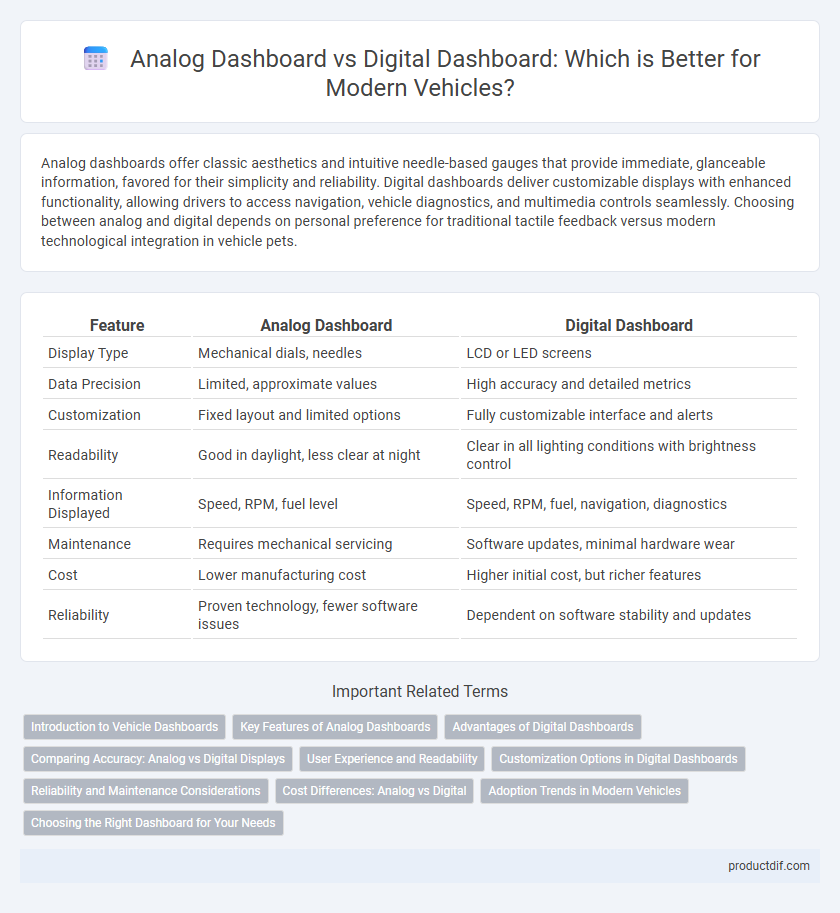Analog dashboards offer classic aesthetics and intuitive needle-based gauges that provide immediate, glanceable information, favored for their simplicity and reliability. Digital dashboards deliver customizable displays with enhanced functionality, allowing drivers to access navigation, vehicle diagnostics, and multimedia controls seamlessly. Choosing between analog and digital depends on personal preference for traditional tactile feedback versus modern technological integration in vehicle pets.
Table of Comparison
| Feature | Analog Dashboard | Digital Dashboard |
|---|---|---|
| Display Type | Mechanical dials, needles | LCD or LED screens |
| Data Precision | Limited, approximate values | High accuracy and detailed metrics |
| Customization | Fixed layout and limited options | Fully customizable interface and alerts |
| Readability | Good in daylight, less clear at night | Clear in all lighting conditions with brightness control |
| Information Displayed | Speed, RPM, fuel level | Speed, RPM, fuel, navigation, diagnostics |
| Maintenance | Requires mechanical servicing | Software updates, minimal hardware wear |
| Cost | Lower manufacturing cost | Higher initial cost, but richer features |
| Reliability | Proven technology, fewer software issues | Dependent on software stability and updates |
Introduction to Vehicle Dashboards
Vehicle dashboards serve as the primary interface for drivers to monitor essential information such as speed, fuel levels, and engine status. Analog dashboards feature mechanical dials and gauges with physical needles, offering a classic and easily interpretable display. Digital dashboards utilize LCD or OLED screens to provide customizable layouts, real-time data integration, and enhanced visibility under various lighting conditions.
Key Features of Analog Dashboards
Analog dashboards feature traditional mechanical gauges with physical needles, providing real-time feedback for speed, fuel levels, and engine temperature through easy-to-read dials. Their tactile design ensures reliability without dependence on software or digital processing, making them less prone to electronic failures. These dashboards offer intuitive visibility in various lighting conditions, appealing to drivers who prefer straightforward, classic instrumentation in their vehicles.
Advantages of Digital Dashboards
Digital dashboards offer enhanced visibility with customizable displays that provide real-time information on speed, fuel efficiency, and engine health, improving driver awareness and safety. Their integration with advanced vehicle systems enables features like GPS navigation, maintenance alerts, and multimedia controls, contributing to a seamless driving experience. Digital dashboards also allow software updates and diagnostics, reducing the need for manual adjustments and increasing overall vehicle performance and reliability.
Comparing Accuracy: Analog vs Digital Displays
Digital dashboards offer higher accuracy with precise numerical readings and real-time data updates, minimizing interpretation errors common in analog displays. Analog dashboards rely on mechanical gauges that may drift or lag, leading to less precise measurements especially in dynamic conditions. The enhanced accuracy of digital displays improves driver awareness and vehicle performance monitoring.
User Experience and Readability
Analog dashboards offer straightforward, real-time visual feedback through physical gauges, enhancing intuitive readability for drivers accustomed to traditional layouts. Digital dashboards provide customizable displays with high-resolution graphics and dynamic information updates, improving user experience through clarity and adaptability in various lighting conditions. Studies show digital interfaces reduce glance time by up to 20%, increasing safety by allowing drivers to access critical data more efficiently.
Customization Options in Digital Dashboards
Digital dashboards offer extensive customization options, allowing drivers to personalize display layouts, color schemes, and information types such as navigation, vehicle diagnostics, and multimedia controls. Unlike analog dashboards with fixed gauges and limited indicators, digital dashboards can adapt dynamically based on driving modes and user preferences. This flexibility enhances driver experience by providing relevant, easily accessible data tailored to individual needs.
Reliability and Maintenance Considerations
Analog dashboards offer high reliability due to their simple mechanical components, which are less prone to software glitches and system failures. Digital dashboards, while providing advanced features and customization, may require more frequent software updates and troubleshooting, increasing maintenance demands. Maintenance for analog dashboards typically involves checking physical connections and gauges, whereas digital systems often need diagnostic tools and specialized expertise.
Cost Differences: Analog vs Digital
Analog dashboards typically incur lower manufacturing and repair costs due to simpler mechanical components and fewer electronic parts. Digital dashboards, incorporating advanced display technologies and integration with vehicle systems, generally demand higher initial investments and specialized maintenance. Over time, digital panels may offer savings through software updates and diagnostics, but upfront cost differences remain significant.
Adoption Trends in Modern Vehicles
Digital dashboards are rapidly becoming the standard in modern vehicles due to their enhanced customization, real-time data display, and integration with advanced driver-assistance systems (ADAS). Adoption trends show a significant increase in digital interfaces, especially in electric and autonomous vehicles, where digital dashboards provide seamless connectivity and improved user experience. Analog dashboards remain in entry-level or classic cars but are increasingly replaced by digital displays offering greater functionality and design flexibility.
Choosing the Right Dashboard for Your Needs
Choosing the right vehicle dashboard depends on your driving preferences and usage, with analog dashboards offering intuitive, real-time needle-based gauge readings preferred by traditionalists. Digital dashboards provide customizable displays, greater information density, and integration with advanced vehicle systems, appealing to tech-savvy drivers seeking enhanced data visualization. Prioritize ease of readability, the type of information needed, and compatibility with your vehicle's technology when selecting between analog and digital dashboards.
Analog dashboard vs Digital dashboard Infographic

 productdif.com
productdif.com